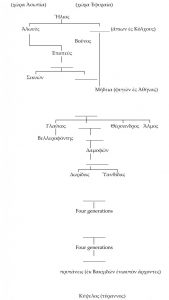[10] Εὔμηλος δὲ Ἥλιον ἔφη δοῦναι τὴν χώραν Ἀλωεῖ μὲν τὴν Ἀσωπίαν, Αἰήτῃ δὲ τὴν Ἐφυραίαν: καὶ Αἰήτην ἀπιόντα ἐς Κόλχους παρακαταθέσθαι Βούνῳ τὴν γῆν, Βοῦνον δὲ Ἑρμοῦ καὶ Ἀλκιδαμείας εἶναι, καὶ ἐπεὶ Βοῦνος ἐτελεύτησεν, οὕτως Ἐπωπέα τὸν Ἀλωέως καὶ τὴν Ἐφυραίων σχεῖν ἀρχήν: Κορίνθου δὲ ὕστερον τοῦ Μαραθῶνος οὐδένα ὑπολειπομένου παῖδα, τοὺς Κορινθίους Μήδειαν μεταπεμψαμένους ἐξ Ἰωλκοῦ παραδοῦναί οἱ τὴν ἀρχήν.
- Map
- Pre Reading
- Post Reading
- Culture Essay
In the first two books of the Periegesis Hellados, Pausanias had not yet settled on a regular pattern for introducing the history of each polis. Thus, in the opening section of Book 2, he gave a quick overview of Corinthian history from Helius to Epopeus and Marathon. Now in this section and the next, he elaborates and provides a fuller account of Corinth’s rulers, using the archaic Corinthian poet Eumelus as his source just as he did in 2.1.1.
As you read this and the following sections, see if you can complete the chart, Rulers of Corinth-fill in the blanks
N/A
Places Named in Pausanias’ description of Corinth (Google Earth): Asopia (Sicyon), Ephyraea (Corinth), Colchis, Iolcus
